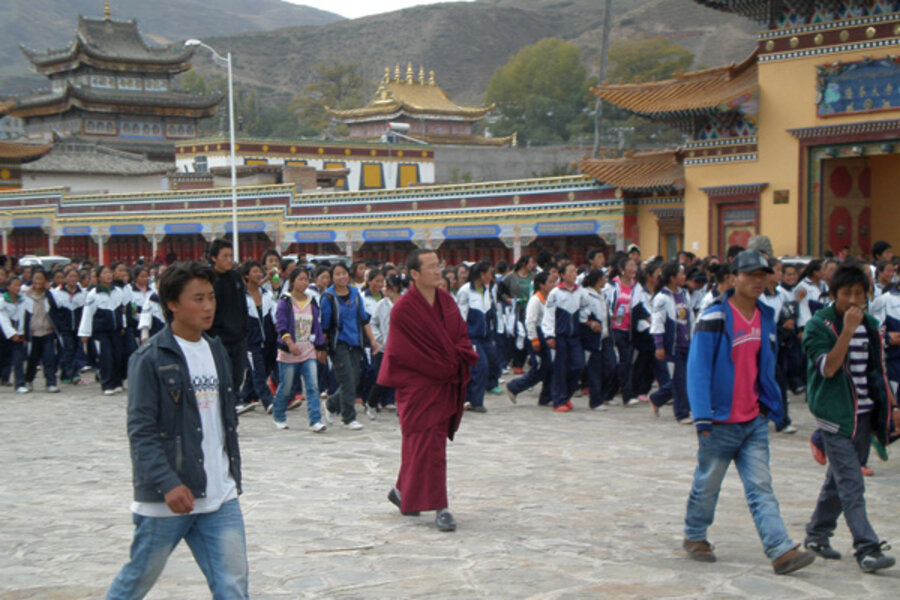Tibet protests Chinese being taught as sole language in regional schools
Loading...
| Beijing
Two years after a wave of anti-government violence spread across China's Tibetan regions, there is a new source of friction in Beijing's relationship with one of its most restive minorities — students marching in protest against reported plans to impose Chinese as the sole language of instruction at schools.
The protest marches, which began earlier this week in the town of Tongren, have spread to nearby areas in the western province of Qinghai, which is home to numerous minority ethnic groups, including Tibetans and Mongolians, who retain their own languages.
The London-based group Free Tibet said hundreds, possibly thousands, of middle, high school and college students joined the demonstrations. No arrests or violence were reported. There was also a similar protest on the campus of a Beijing university.
For authorities, any sign of unrest among Tibetans is seen as a threat to national sovereignty and a reminder of past uprisings against China's often heavy-handed rule over the area.
Brewing discontent with Beijing's policies exploded into deadly rioting in Tibet's capital Lhasa in 2008, then spread like wildfire through traditionally Tibetan areas such as Tongren that lie outside the official Tibetan Autonomous Region.
The government says at least 22 people were killed in Lhasa, while Tibetan rights groups say nearly 140 Tibetans died in the violence, including 19 in neighboring Gansu province. Tibetan areas remain among China's most restive regions, with a heavy security presence keeping a close eye on residents.
The current round of protests is unlikely to spark widespread violence because it is focused on practical concerns rather than identifying with the Tibetan independence cause, said Dibyesh Anand, a Tibet expert at London's Westminster University.
"The protests are more similar to numerous protests inside China over social, economic and cultural grievances. None of them challenge the authority of the state. They demand better conditions within the system," Anand said.
So far, the government and state media have kept mostly mum on the student protests, although the official English-language Global Times newspaper sought to downplay them and defended China's language policies.
"Students may not understand policy on language," said the paper, which chiefly targets foreign readers with positive reports on government actions.
The protests appear to have been sparked by remarks by Qiang Wei, Qinghai province's Communist Party chief, who was quoted last month by the Communist Party's official newspaper as praising the use of a "common language" in schools.
Students fear that means the current bilingual system will be scrapped in favor of using Mandarin Chinese alone, except in language classes.
A report on Qinghai's plans for educational reform over the next decade was even more explicit, saying "the nation's common language must become the language of instruction."
Use of the Tibetan language is tied to the region's political struggles. Many Tibetans argue they have traditionally been self-governing and that Chinese policies are wrecking their unique Buddhist culture. But the issue is complicated because while many Tibetans feel threatened by development and the migration of China's ethnic Han majority, some also hope their children master Mandarin in order to obtain better jobs.
Beijing defends its policies, saying they spur economic growth in the largely poor areas, but implementation has often been blunt and heedless of local opinion.
About 500 students at the Beijing campus of Minzu University of China, a leading institution for ethnic minority students, protested for language rights Friday. Pictures posted on Twitter showed a group of students carrying a banner saying "Protect ethnic minority languages, carry forward Chinese civilization."
School officials, including the university's chancellor and Communist Party secretary, met with the students and asked them to submit their concerns on paper, which they promised to then forward to higher authorities, said a Tibetan graduate student, who declined to give his name for fear of retaliation.
He said the rally broke up peacefully after about two hours. Word of the rally was also sent out by Tibetan activists overseas and posted to websites.
Calls to university administration offices rang unanswered Friday afternoon.
On Tuesday, students who were joined in some cases by Buddhist monks went from school to school in Tongren carrying signs and chanting slogans calling for equality among ethnic groups and the right to learn in Tibetan.
Teachers at area schools confirmed the protests and said classes resumed soon afterward.
However, calls Friday to more than a dozen government offices, police stations and schools in Tongren and surrounding towns were answered by people who either refused to discuss the matter or claimed the marches didn't happen — a likely sign that the local government has ordered a news blackout.
Free Tibet said the local governor and education department visited a teacher's college in Tongren on Wednesday and threatened to expel students who organize more marches.





